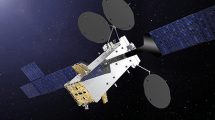 ST Engineering iDirect has unveiled a significant upgrade to its Mx-DMA MRC return technology. The waveform can now support 300 Mbps on a single return channel, achieving over 1 Gbps of throughput when combined with 800 Mbps DVB-S2X on the outbound in VSAT mode.
ST Engineering iDirect has unveiled a significant upgrade to its Mx-DMA MRC return technology. The waveform can now support 300 Mbps on a single return channel, achieving over 1 Gbps of throughput when combined with 800 Mbps DVB-S2X on the outbound in VSAT mode.
Mx-DMA MRC shares the same capacity, multiplexing different terminals into one capacity pool and enabling service providers to mix high-throughput and very low data users on the same beam. Satellite service provider Speedcast will leverage the waveform’s performance upgrade which will enable the company to use a single return technology across its entire maritime network, particularly to provide extended performance to bandwidth-intensive customer sets, including those across the cruise sector.
The waveform offers a record 100 Mega symbol per second (Msps), up from 25 Msps. The new symbol rate, or its bitrate conversion of 300 Mbps, creates three times as much throughput as before. The newly extended performance is available on the MDM5010 modem.
Will Mudge, VP of Engineering Operations at Speedcast, said: “This advancement in technology will enable a better experience for customers. Increasing MX-DMA’s capability to 100 Msps allows customers access to more bandwidth in a dynamic network pool versus a static SCPC link return, resulting in a more seamless experience with ever-growing expectations for bandwidth delivery.”
Sean Yarborough, VP of Product Management at ST Engineering iDirect, added: “We are delighted that we are able to offer Speedcast a solution that enables it to meet the unique requirements of every customer profile with the best possible connectivity experience, assured availability and reliability. It’s the ultimate in scalable return technology.”
Introduced to the market in 2020, Mx-DMA MRC is a return link technology that combines the benefits of MF-TDMA and the spectrum efficiency of SCPC into a single return technology suited to a greatly expanded set of applications.
Mx-DMA scales in MHz independent of the number of terminals so customers may be served with a single return link for the majority of their use cases, minimising operational complexity and maximising statistic multiplexing. Mx-DMA MRC delivers these benefits by maintaining spectral efficiency and performance while drastically improving agility, scalability and fill efficiency. Designing an Mx-DMA MRC link does not require precise knowledge of the traffic and terminal mix as the link self-optimises in real-time. Moreover, the high efficiency enables bandwidth savings, higher throughput, better network availability and substantial terminal cost savings.












Add Comment